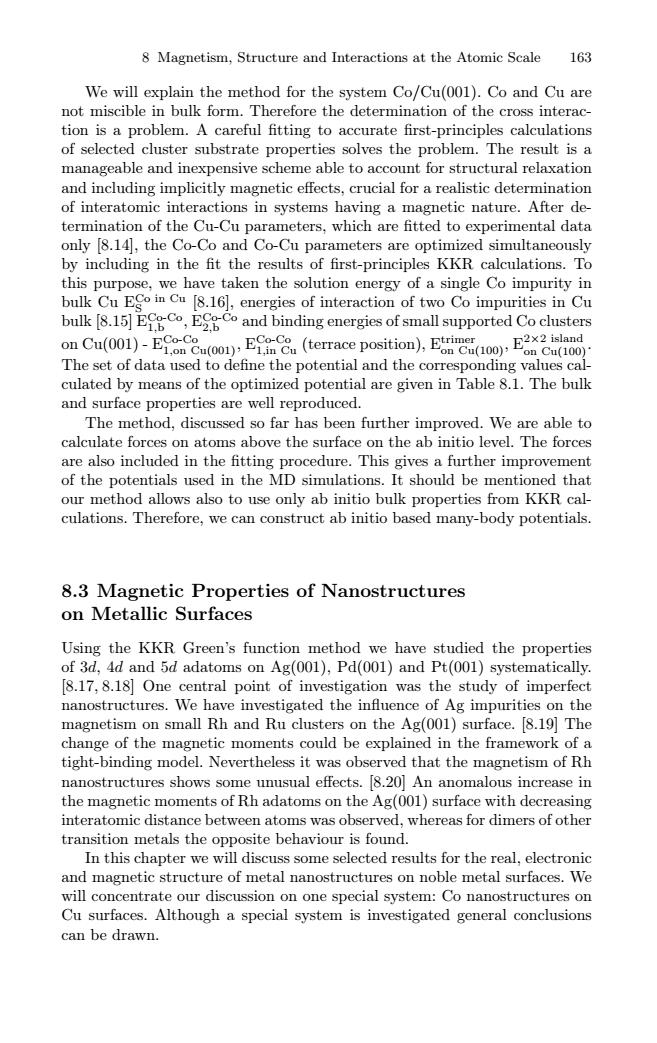正在加载图片...

8 Magnetism,Structure and Interactions at the Atomic Scale 163 We will explain the method for the system Co/Cu(001).Co and Cu are not miscible in bulk form.Therefore the determination of the cross interac- tion is a problem.A careful fitting to accurate first-principles calculations of selected cluster substrate properties solves the problem.The result is a manageable and inexpensive scheme able to account for structural relaxation and including implicitly magnetic effects,crucial for a realistic determination of interatomic interactions in systems having a magnetic nature.After de- termination of the Cu-Cu parameters,which are fitted to experimental data only 8.14,the Co-Co and Co-Cu parameters are optimized simultaneously by including in the fit the results of first-principles KKR calculations.To this purpose,we have taken the solution energy of a single Co impurity in bulk Cu ESo in Cu [8.16],energies of interaction of two Co impurities in Cu bulk 815]EoEand binding energies of small supported Co clusters oCu(100)E2x2 island on Cu(001)-E)E(terrace position),E on Cu(100) The set of data used to define the potential and the corresponding values cal- culated by means of the optimized potential are given in Table 8.1.The bulk and surface properties are well reproduced. The method,discussed so far has been further improved.We are able to calculate forces on atoms above the surface on the ab initio level.The forces are also included in the fitting procedure.This gives a further improvement of the potentials used in the MD simulations.It should be mentioned that our method allows also to use only ab initio bulk properties from KKR cal- culations.Therefore,we can construct ab initio based many-body potentials. 8.3 Magnetic Properties of Nanostructures on Metallic Surfaces Using the KKR Green's function method we have studied the properties of 3d,4d and 5d adatoms on Ag(001),Pd(001)and Pt(001)systematically. 8.17,8.18 One central point of investigation was the study of imperfect nanostructures.We have investigated the influence of Ag impurities on the magnetism on small Rh and Ru clusters on the Ag(001)surface.[8.19]The change of the magnetic moments could be explained in the framework of a tight-binding model.Nevertheless it was observed that the magnetism of Rh nanostructures shows some unusual effects.8.20]An anomalous increase in the magnetic moments of Rh adatoms on the Ag(001)surface with decreasing interatomic distance between atoms was observed,whereas for dimers of other transition metals the opposite behaviour is found. In this chapter we will discuss some selected results for the real,electronic and magnetic structure of metal nanostructures on noble metal surfaces.We will concentrate our discussion on one special system:Co nanostructures on Cu surfaces.Although a special system is investigated general conclusions can be drawn.8 Magnetism, Structure and Interactions at the Atomic Scale 163 We will explain the method for the system Co/Cu(001). Co and Cu are not miscible in bulk form. Therefore the determination of the cross interaction is a problem. A careful fitting to accurate first-principles calculations of selected cluster substrate properties solves the problem. The result is a manageable and inexpensive scheme able to account for structural relaxation and including implicitly magnetic effects, crucial for a realistic determination of interatomic interactions in systems having a magnetic nature. After determination of the Cu-Cu parameters, which are fitted to experimental data only [8.14], the Co-Co and Co-Cu parameters are optimized simultaneously by including in the fit the results of first-principles KKR calculations. To this purpose, we have taken the solution energy of a single Co impurity in bulk Cu ECo in Cu S [8.16], energies of interaction of two Co impurities in Cu bulk [8.15] ECo-Co 1,b , ECo-Co 2,b and binding energies of small supported Co clusters on Cu(001) - ECo-Co 1,on Cu(001), ECo-Co 1,in Cu (terrace position), Etrimer on Cu(100), E2×2 island on Cu(100). The set of data used to define the potential and the corresponding values calculated by means of the optimized potential are given in Table 8.1. The bulk and surface properties are well reproduced. The method, discussed so far has been further improved. We are able to calculate forces on atoms above the surface on the ab initio level. The forces are also included in the fitting procedure. This gives a further improvement of the potentials used in the MD simulations. It should be mentioned that our method allows also to use only ab initio bulk properties from KKR calculations. Therefore, we can construct ab initio based many-body potentials. 8.3 Magnetic Properties of Nanostructures on Metallic Surfaces Using the KKR Green’s function method we have studied the properties of 3d, 4d and 5d adatoms on Ag(001), Pd(001) and Pt(001) systematically. [8.17, 8.18] One central point of investigation was the study of imperfect nanostructures. We have investigated the influence of Ag impurities on the magnetism on small Rh and Ru clusters on the Ag(001) surface. [8.19] The change of the magnetic moments could be explained in the framework of a tight-binding model. Nevertheless it was observed that the magnetism of Rh nanostructures shows some unusual effects. [8.20] An anomalous increase in the magnetic moments of Rh adatoms on the Ag(001) surface with decreasing interatomic distance between atoms was observed, whereas for dimers of other transition metals the opposite behaviour is found. In this chapter we will discuss some selected results for the real, electronic and magnetic structure of metal nanostructures on noble metal surfaces. We will concentrate our discussion on one special system: Co nanostructures on Cu surfaces. Although a special system is investigated general conclusions can be drawn